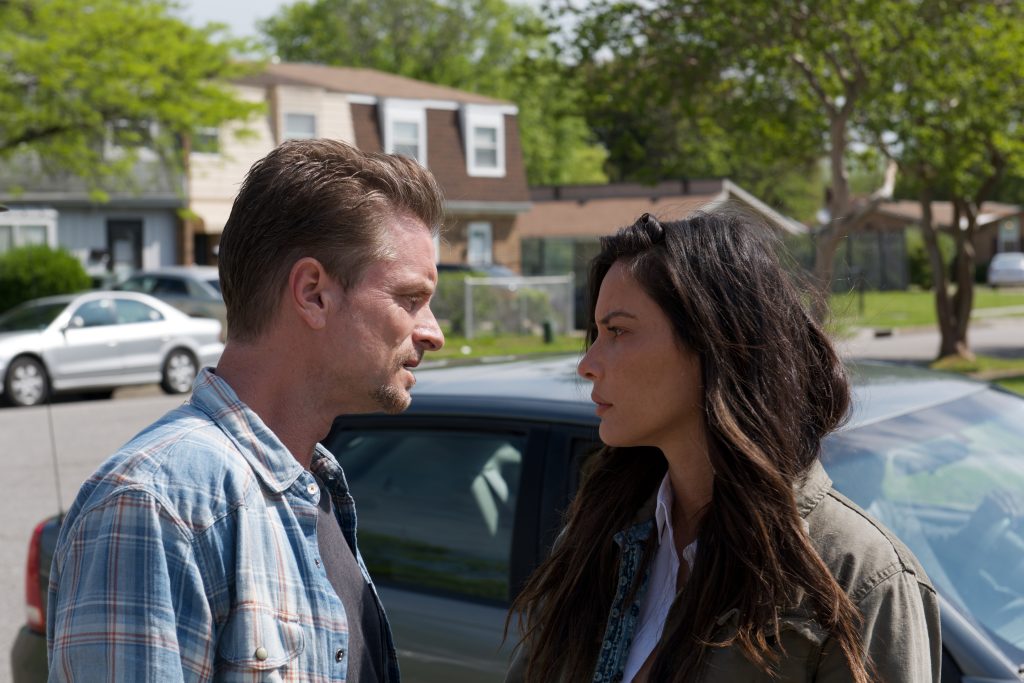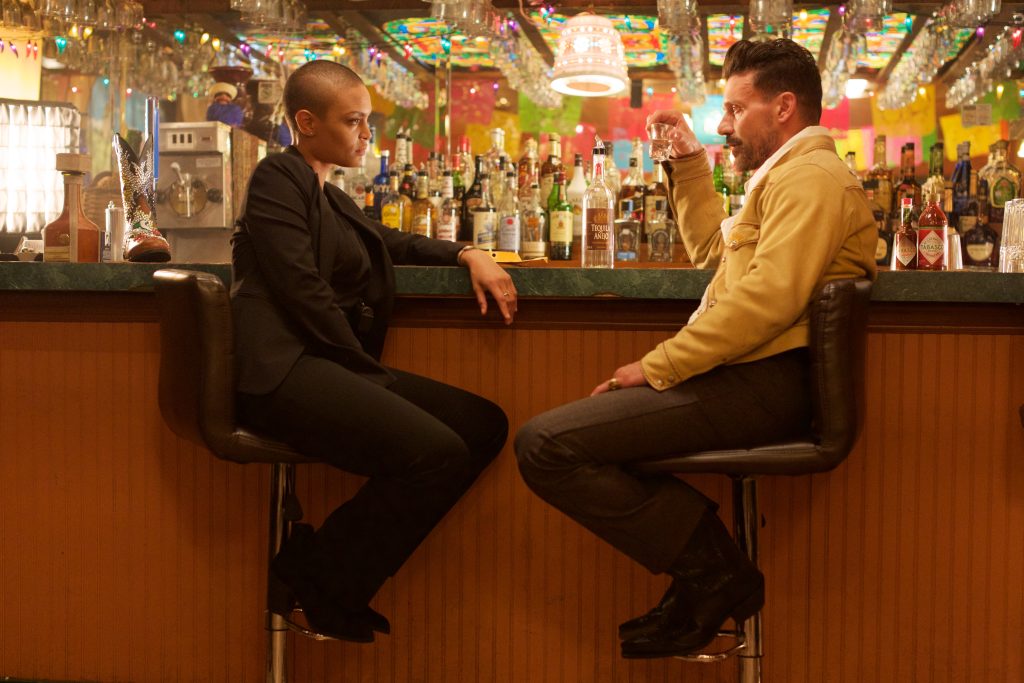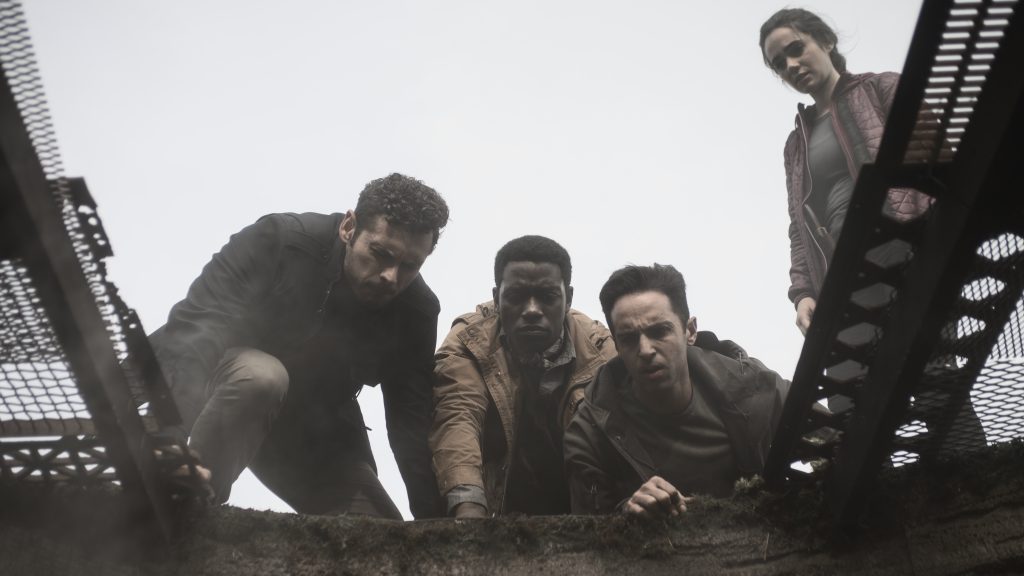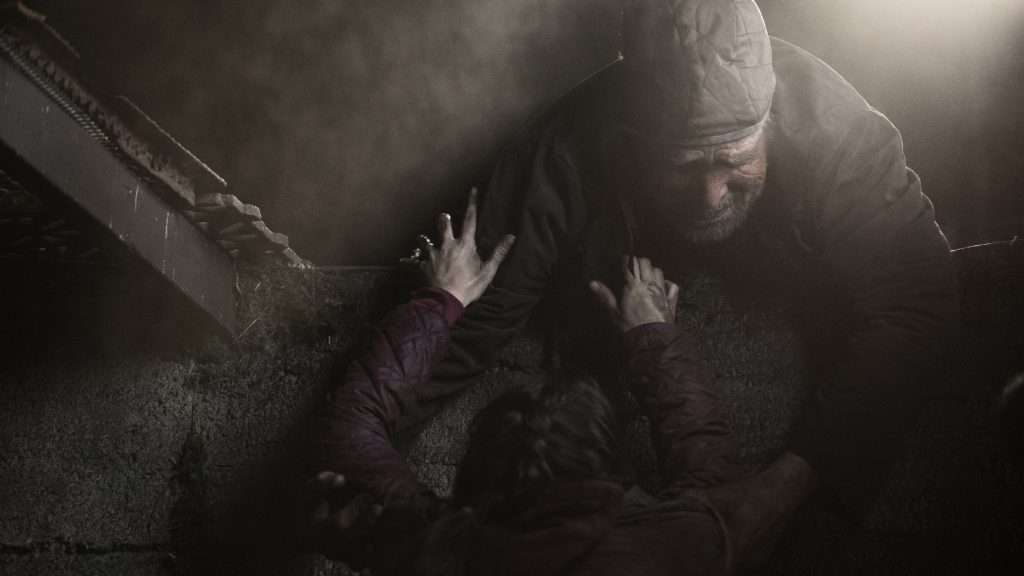December 28, 2021
by Carla Hay

Directed by Michele Civetta
Culture Representation: Taking place in an unnamed U.S. city, the dramatic film “The Gateway” features a predominantly white cast of characters (with some African Americans, Latinos and Asians) representing the working-class, middle-class and criminal underground.
Culture Clash: A well-meaning bachelor, who works for a city’s social services department, finds himself caught up in criminal warfare when he tries to protect a mother and her young daughter after the child’s father gets out of prison.
Culture Audience: “The Gateway” will appeal primarily to people who are interested in forgettable and formulaic crime dramas.

“The Gateway” is such a generic and unimaginative rehash of many other crime dramas, it’s likely to be soon forgotten after people see it. It’s yet another story about a hero who has an “against all odds” struggle against gangster thugs. In “The Gateway,” the protagonist does battle against drug-dealing goons, in order to save (cliché alert) a damsel in distress and her child. It’s all very hackneyed and boring. There’s absolutely nothing creative about this movie, which lumbers along until its very predictable end.
“The Gateway” was directed by Michele Civetta, who co-wrote the drab screenplay with Alex Felix Bendaña and Andrew Levitas. The movie is Civetta’s second feature film as a director. His feature-film directorial debut was the unremarkable 2020 horror flick “Agony,” which describes what any viewer might have felt if they watched that painfully dull film. And although Civetta says in “The Gateway” production notes that “The Gateway” was inspired by crime thrillers such as John Huston’s “Fat City” (released in 1972) and John Cassavetes’ “The Killing of a Chinese Bookie” (released in 1976), “The Gateway” has none of the intrigue or style of those films.
The name of the U.S. city where “The Gateway” takes place is never shown or mentioned by the characters in the movie, which was actually filmed in Norfolk, Virginia. Wherever “The Gateway” is supposed to take place, it’s a city where gambling is legal, because the “damsel in distress” is a blackjack dealer in a casino. She’s not the movie’s protagonist though. The story’s main character is yet another stereotype of a “regular Joe” who suddenly has to battle gangsters as if he’s an experienced member of law enforcement. Yawn.
The protagonist of “The Gateway” is Parker (played by Shea Whigham), a lonely middle-aged bachelor whose life revolves around his job working as an investigator for the city’s social services department. In the movie’s opening scene, viewers see that Parker is compassionate when he responds to a complaint about child endangerment in a house that’s basically a drug den. Parker finds a boy at the house who’s about 7 years old, and he comforts the boy when it’s discovered that the boy’s mother has overdosed. Two men in the house are then arrested.
For an unspecified period of time, Parker has been looking out for another child named Ashley (played by Taegen Burns), who’s about 12 years old. His interest in Ashley extends beyond his social worker job. He has become somewhat of a father figure to Ashley, whose father has been in prison for an untold number of years. Ashley’s mother Dahlia (played by Olivia Munn) has been raising Ashley while Dahlia holds down a job as a blackjack dealer.
Viewers never see any flashbacks of how Parker became close to this family, so the relationship that he has with Dahlia and Ashley feels too rushed and contrived in this movie. As an example of how Parker goes beyond his social worker duties for Ashley, Parker volunteers to take Ashley to school when he’s needed. It’s hinted that maybe Parker is attracted to Dahlia, but he doesn’t cross the line into making any inappropriate and unprofessional moves on her.
Dahlia might have a substance abuse problem, because the reason why Parker takes Ashley to school in an early scene in the movie is because she seems to be drunk or high, and Parker doesn’t want Dahlia to drive under the influence. The dynamics between Parker, Dahlia and Ashley change when Ashley’s father Mike (played by Zach Avery) gets out of prison and makes it clear to Parker that Mike wants to be the only father figure in Ashley’s life.
Soon after Mike get out of prison, he goes right back into a criminal lifestyle. At a bar frequented by shady people, Mike meets up with a local drug kingpin named Duke (played by Frank Grillo, in yet another one of his “tough guy” roles) to set up a heroin deal. Mike tells Duke and Duke’s associate Louis (played by Alexander Wraith) that Mike knows about two bricks of heroin that were stolen from a Mexican drug cartel.
Mike offers to deliver this heroin to Duke. In exchange, Duke says that he will set Mike and Louis up with enough money for Mike and Louis to open their own bar. Duke also offers to lend out the services of his henchman Hector (played by Mounir Quazzani) to help Mike and Louis for protection in retrieving this heroin, which is hidden in a place that could be guarded.
“The Gateway,” which already has a very simple-minded plot that would barely be enough for a short film, stretches everything out to tedious levels with repetitious scenes of Mike and his cronies committing crimes; Mike and Dahlia having tensions in their already shaky relationship; and Mike threatening Parker to stay away from Ashley. Parker was assigned to check on the welfare of Ashley, so he tells Mike that it would be up to the city to decide when Parker will no longer have to check up on her.
This movie is so poorly written that it does little to show who Parker is as a person. The only thing about his personal life that’s shown is that he has a rocky relationship with his father Marcus (played by Bruce Dern), because (as shown in flashbacks) Marcus was a verbally abusive alcoholic to Parker when Parker was a child. In fact, all of the characters in the movie don’t have much depth or personality. They’re just hollow vessels to act out the movie’s unimpressive action scenes. Two police detectives named Detective Vaughn (played by Shannon Adawn) and Detective Bachman (played by Nick Daly) are essentially useless, since this movie is about making Parker the biggest hero.
Needless to say in a predictable movie like “The Gateway,” Parker, Dahlia and Ashley unwittingly get caught up in Mike’s big heroin deal when the heroin stash goes missing. Expect the usual chase scenes and shootouts that clog up substandard thrillers such as “The Gateway.” The cast members and the filmmakers don’t put much effort into bringing any creative spark to this tired story. With all the better-quality movies that have already been made about drug deals gone bad, viewers don’t have to waste their time on “The Gateway.”
Lionsgate released “The Gateway” in select U.S. cinemas and on digital and VOD on September 3, 2021. The movie was released on Blu-ray and DVD on September 7, 2021.


